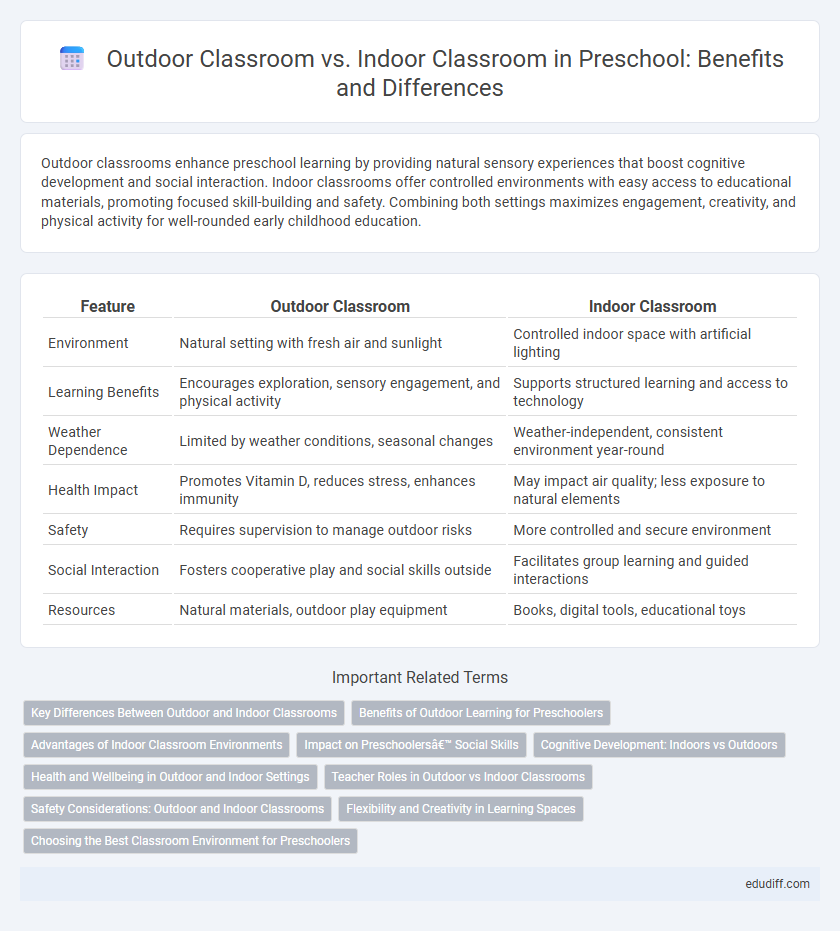Outdoor classrooms enhance preschool learning by providing natural sensory experiences that boost cognitive development and social interaction. Indoor classrooms offer controlled environments with easy access to educational materials, promoting focused skill-building and safety. Combining both settings maximizes engagement, creativity, and physical activity for well-rounded early childhood education.
Table of Comparison
| Feature | Outdoor Classroom | Indoor Classroom |
|---|---|---|
| Environment | Natural setting with fresh air and sunlight | Controlled indoor space with artificial lighting |
| Learning Benefits | Encourages exploration, sensory engagement, and physical activity | Supports structured learning and access to technology |
| Weather Dependence | Limited by weather conditions, seasonal changes | Weather-independent, consistent environment year-round |
| Health Impact | Promotes Vitamin D, reduces stress, enhances immunity | May impact air quality; less exposure to natural elements |
| Safety | Requires supervision to manage outdoor risks | More controlled and secure environment |
| Social Interaction | Fosters cooperative play and social skills outside | Facilitates group learning and guided interactions |
| Resources | Natural materials, outdoor play equipment | Books, digital tools, educational toys |
Key Differences Between Outdoor and Indoor Classrooms
Outdoor classrooms offer experiential learning through natural environments, promoting sensory engagement and physical activity, whereas indoor classrooms provide controlled settings equipped with structured materials and technological resources. Outdoor spaces encourage exploration and social interaction with diverse stimuli, contrasting with the indoor focus on organized curricula and minimized distractions. Safety considerations and weather conditions also distinguish the two, influencing scheduling and teaching methods in preschool education.
Benefits of Outdoor Learning for Preschoolers
Outdoor classrooms enhance preschoolers' sensory development and motor skills by providing diverse natural stimuli and ample space for physical activity. Exposure to fresh air and sunlight boosts immune function and supports emotional well-being, reducing stress and increasing focus. Engaging with nature fosters creativity and environmental awareness, laying a foundation for lifelong learning and sustainable habits.
Advantages of Indoor Classroom Environments
Indoor classroom environments in preschools offer controlled climate conditions that promote comfort and health, reducing exposure to allergens and weather-related disruptions. They provide consistent access to educational materials and technology, enhancing interactive learning experiences and supporting varied sensory activities. Safety is better managed indoors, with secure boundaries and fewer risks from outdoor elements, fostering a focused and nurturing setting for early childhood development.
Impact on Preschoolers’ Social Skills
Outdoor classrooms enhance preschoolers' social skills by encouraging cooperative play and communication through interactive, nature-based activities. Exposure to open environments promotes teamwork and conflict resolution as children navigate shared spaces and resources. Indoor classrooms provide structured settings that support guided social interactions and focused group learning but may limit spontaneous social engagement opportunities.
Cognitive Development: Indoors vs Outdoors
Outdoor classrooms enhance cognitive development in preschoolers by providing multisensory experiences that stimulate curiosity and problem-solving skills. Natural settings encourage exploration and creativity, fostering executive function and attention span more effectively than traditional indoor environments. Indoor classrooms, while structured for focused learning, may limit physical movement and sensory engagement, impacting the depth of cognitive growth.
Health and Wellbeing in Outdoor and Indoor Settings
Outdoor classrooms promote children's health and wellbeing by increasing exposure to natural sunlight and fresh air, which supports vitamin D synthesis and respiratory health. In contrast, indoor classrooms may have limited ventilation and higher exposure to indoor pollutants, potentially affecting air quality and increasing the risk of respiratory issues. Regular outdoor learning enhances physical activity, reduces stress, and supports emotional wellbeing, making it a critical component of early childhood education environments.
Teacher Roles in Outdoor vs Indoor Classrooms
Teachers in outdoor classrooms facilitate experiential learning by guiding children to explore natural environments, encouraging curiosity, and promoting sensory development. In indoor classrooms, teachers focus more on structured activities, direct instruction, and managing classroom routines to foster cognitive skills and social interactions. Both settings require adaptive teaching strategies, but outdoor environments demand greater emphasis on safety supervision and spontaneous learning opportunities.
Safety Considerations: Outdoor and Indoor Classrooms
Outdoor classrooms require thorough risk assessments to address hazards like uneven terrain, weather exposure, and insect bites, ensuring all play and learning areas are secure and child-friendly. Indoor classrooms demand strict adherence to fire safety codes, proper ventilation, and safe storage of materials to prevent accidents and maintain a healthy environment. Both settings benefit from well-trained staff vigilant in emergency procedures and child supervision, significantly enhancing overall safety.
Flexibility and Creativity in Learning Spaces
Outdoor classrooms in preschool settings offer greater flexibility by incorporating natural elements and diverse play areas that stimulate imaginative learning and sensory exploration. Indoor classrooms provide controlled environments with structured resources and technology to support focused activities and academic routines. Balancing both spaces enhances creativity by allowing children to engage in unstructured outdoor play while benefiting from organized indoor instruction.
Choosing the Best Classroom Environment for Preschoolers
Outdoor classrooms provide preschoolers with natural sensory experiences that promote physical development and social interaction, while indoor classrooms offer controlled environments that support focused learning and safety. Selecting the best classroom environment depends on balancing exposure to nature with opportunities for structured activities, ensuring that children develop cognitive, emotional, and motor skills effectively. Incorporating flexible learning spaces that combine both outdoor and indoor elements enhances overall preschool education outcomes.
Outdoor classroom vs Indoor classroom Infographic

 edudiff.com
edudiff.com